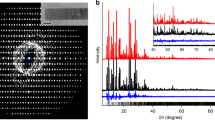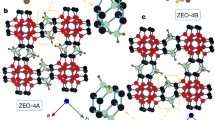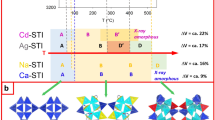Abstract
Zeolite beta, first described in 19671, is an active catalyst and a useful sorbent1. Sorption1,2 and catalytic data3,4 suggest that the zeolite could possess a three-dimensional 12-ring pore system. Such a pore system suggests technological potential similar to that of faujasite framework materials, but until now the structure of this zeolite has eluded determination. Powder X-ray diffraction patterns comprise both sharp and broad features, indicative of an extensively faulted structure. Here we determine the structure of zeolite beta by high-resolution electron microscopy, electron diffraction and computer-assisted modelling. The zeolite is an intergrown hybrid of two distinct but closely related structures. Both are constructed from the same centrosymmetrlcal tertiary building unit arranged in layers, and both possess three-dimensional 12-ring pore systems. One end member, polymorph A, forms an enantiomorphic pair, with symmetries P4122 and P4322, with a = 12.4 Å and c = 26.5 Å. Polymorpb B, in which the stacking of layers alternates in handedness, is achiral with space group P1 ¯, and a ≃ b = 12.4 Å, c = 14.5 Å, α ≃ β = 73°, γ ≃ 90°. The high density of stacking faults in zeolite beta materials arises because successive layers must interconnect in either a left- or a right-handed fashion, and both modes of linkage occur with almost equal probability.
This is a preview of subscription content, access via your institution
Access options
Subscribe to this journal
Receive 51 print issues and online access
$199.00 per year
only $3.90 per issue
Buy this article
- Purchase on Springer Link
- Instant access to full article PDF
Prices may be subject to local taxes which are calculated during checkout
Similar content being viewed by others
References
Wadlinger, R. L., Kerr, G. T. & Rosinski, E. J. US Patent No. 3,308,069 (Mobil Oil Corporation, 1967).
Bond, A. E., Burgess, C. G. V. & Martin, D. E. US Patent No. 3,793,385 (BP PLC, 1974).
Martens, J. A., Tielen, M., Jacobs, P. A. & Weitkamp, J. Zeolites 4, 98–107 (1984).
Martens, J. A., Perez-Pariente, J. & Jacobs, P. A. Acta phys. chem. 31, 487–495 (1985).
Perez-Pariente, J., Martens, J. A. & Jacobs, P. A. Appl. Catal. 31, 35–64 (1987).
LaPierre, R. B. et al. Zeolites 5, 346–348 (1985).
Meier, W. M. & Olson, D. H. Atlas of Zeolite Structure Types 2nd edn (Butterworth, Oxford, in the press).
Meier, W. M. & Villiger, H. Z. Kristallogr. Kristallgeom. 129, 411–423 (1969).
Baerlocher, C., Hepp, A. & Meier, W. M. DLS-76 Manual (ETH, Zurich, 1977).
O'Keefe, M. A. & Buseck, P. R. Trans. Am. crystallogr. Ass. 15, 27 (1979).
Author information
Authors and Affiliations
Rights and permissions
About this article
Cite this article
Treacy, M., Newsam, J. Two new three-dimensional twelve-ring zeolite frameworks of which zeolite beta is a disordered intergrowth. Nature 332, 249–251 (1988). https://doi.org/10.1038/332249a0
Received:
Accepted:
Issue Date:
DOI: https://doi.org/10.1038/332249a0
This article is cited by
-
Cascade conversion of glucose to 5-hydroxymethylfurfural over Brönsted-Lewis bi-acidic SnAl-beta zeolites
Korean Journal of Chemical Engineering (2021)
-
Comparative Study of SO2 and SO2/SO3 Poisoning and Regeneration of Cu/BEA and Cu/SSZ-13 for NH3 SCR
Emission Control Science and Technology (2021)
-
A Perspective on the Relationship Between Microstructure and Performance of Cu-Based Zeolites for the Selective Catalytic Reduction of NOx
Catalysis Surveys from Asia (2020)
-
Copper Behavior and Fayalite Microstructure Changes Influenced by Cu2O Dissolution
JOM (2019)
-
Dioxin and 1,2-dichlorobenzene adsorption in aluminosilicate zeolite Beta
Adsorption (2017)
Comments
By submitting a comment you agree to abide by our Terms and Community Guidelines. If you find something abusive or that does not comply with our terms or guidelines please flag it as inappropriate.



